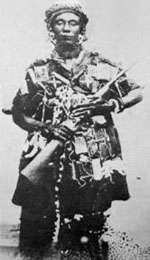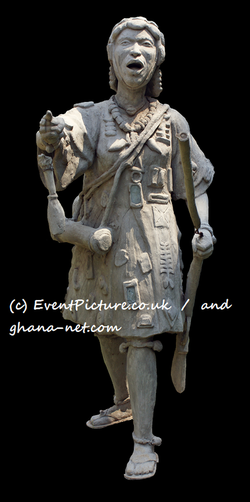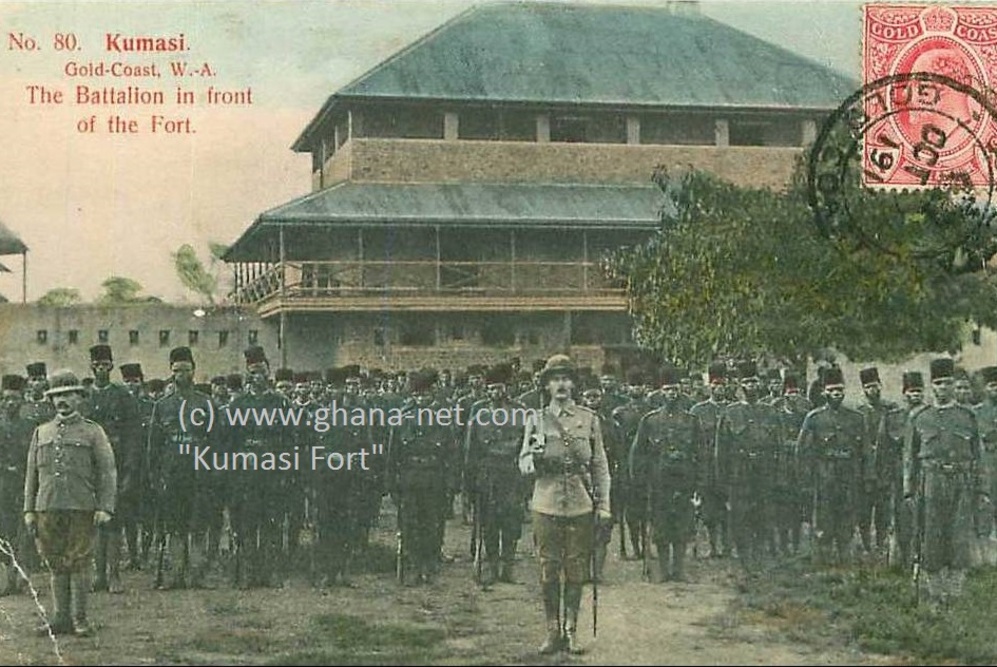''Now I have seen that some of you fear to go forward to fight for our King. If it were in the brave days of Osei Tutu, Okomfo Anokye, and Opoku Ware, leaders would not sit down to see their King taken away without firing a shot. No white man could have dared to speak to a leader of the Ashanti in the way the Governor spoke to you this morning.Is it true that the bravery of the Ashanti is no more? I cannot believe it. It cannot be! I must say this, if you the men of Ashanti will not go forward, then we will. We the women will. I shall call upon my fellow women. We will fight the white men. We will fight till the last of us falls in the battlefields.''
Yaa Asantewaa (c. 1840 – 17 October 1921) (pronounced YAA A-san-TE-WAA) was a legendary Ghanaian queen mother, political leader, and military commander. She held the title of Queen Mother of Ejisu, a town within the Ashanti Empire (in present-day Ghana), and played a defining role in resisting British colonial domination in West Africa at the turn of the 20th century.
She was appointed Queen Mother by her brother, Nana Akwasi Afrane Okpese, the Ejisuhene (chief of Ejisu). In the matrilineal Ashanti system, the Queen Mother was not merely a ceremonial figure but wielded significant political power—including the right to nominate and depose rulers, advise on state matters, and act as the guardian of national traditions.

Vision for the new Yaa Asantewaa Memorial Heritage Museum

Yaa Asantewaa in a traditional war dress (unknown time)
Yaa Asantewaa is best known for her leadership during the War of the Golden Stool in 1900, also referred to as the Ashanti Uprising of 1900. This pivotal conflict was sparked by the British colonial governor, Sir Frederick Hodgson, who demanded to sit on the sacred Golden Stool—a symbol of the soul, unity, and sovereignty of the Ashanti nation. The request was seen not only as deeply disrespectful but as a direct challenge to Ashanti identity and independence.
At the time, the Ashanti king, Prempeh I, and other high-ranking leaders had been exiled by the British to the Seychelles, leaving the empire vulnerable and politically destabilized. In the face of this crisis, a council of Ashanti chiefs met to discuss how to respond. When the men hesitated, fearing the might of British forces, it was Yaa Asantewaa who stood and delivered a now-famous speech, reportedly declaring:
“If you, the men of Ashanti, will not go forward, then we will. We, the women, will fight. We will fight till the last of us falls in the battlefields.”

Statue at National Museum of Ghana (c) Remo Kurka
With this declaration, Yaa Asantewaa mobilized an army of several thousand and led the resistance herself—becoming one of the very few women in African history to lead a major war against European colonizers.
Her forces laid siege to the British fort at Kumasi, the Ashanti capital, effectively trapping the colonial governor and his troops for several months. Although the rebellion was eventually suppressed by British reinforcements, the Ashanti resistance shocked the British Empire and demonstrated the fierce resolve of African resistance movements.
Yaa Asantewaa was captured in 1901 and exiled, like many of her contemporaries, to the Seychelles, where she died in 1921. Though she did not live to see the independence of Ghana, her courage and leadership became a powerful symbol of anti-colonial resistance and feminist heroism in Africa.
Today, Yaa Asantewaa is celebrated across Ghana and beyond as a national heroine. Numerous schools, cultural festivals, and institutions bear her name, including the Yaa Asantewaa Girls’ Secondary School in Kumasi. Her legacy remains central to the history of Ghana's independence movement and to broader discussions of African women’s leadership in history.
Yaa Asantewaa was captured by British forces in 1901 and exiled to the Seychelles, where she died in 1921. Although she did not live to witness Ghana’s eventual independence in 1957—the first sub-Saharan African country to break free from colonial rule—her resistance became a powerful rallying point for future generations of freedom fighters. - Read More Here

Yaa Asantewaah Museum
Address of Museum:
P.O. Box 12
Ejisu, C/O The Hon. District Chief Executive, Ejisu Juaben District Assembly
Ejisu, Ashanti Region, Ghana
Type of Museum: Memorial
Status: District Museum
Year established: 2000
Governing Bodies: National Commission on Culture and the Ejisu-Juaben District Assembly.
Collections: Personal properties of Nana Yaa Asantewaa, the Warrior Queen mother.